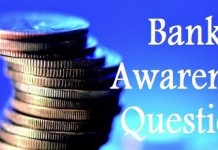Hello Aspirants,
Welcome to Banking Awareness Quiz in AffairsCloud.com. Here we are creating quiz covering important questions which are common for all the bank exams and other competitive exams.
- ATMs set up, owned and operated by non-banks are called ______
A. White Label ATMs
B. Brown Label ATMs
C. Green Label ATMs
D. None of the AboveA. White Label ATMs
Explanation:
ATMs set up, owned and operated by non-banks are called White Label ATMs. Sponsor Bank provides cash for White Label ATMs. Non-bank ATM operators are authorized under Payment & Settlement Systems Act, 2007 by the RBI.. - Deposit Insurance and Credit Guarantee Corporation (DICGC) is a subsidiary of RBI, head quartered at_______
A. Bengaluru
B. Hyderabad
C. Mumbai
D. NoidaC. Mumbai
Explanation:
DICGC is a subsidiary of RBI which was established on 15 July 1978 under Deposit Insurance and Credit Guarantee Corporation Act, 1961 for the purpose of providing insurance of deposits and guaranteeing of credit facilities. The Head Office of the DICGC is located at Mumbai. - What is the maximum deposit amount insured by the Deposit Insurance and Credit Guarantee Corporation(DICGC)?
A. Rs. 1,00,000
B. Rs. 2,00,000
C. Rs. 3,00,000
D. Rs. 5,00,000A. Rs. 1,00,000
Explanation:
DICGC insures all bank deposits, such as saving, fixed, current, recurring deposits for up to the limit of Rs.100,000 of each deposits in a bank. - Which of the following is/are insured by DICGC?
A. Local Area Banks
B. RRBs
C. All commercial Banks
D. All of the AboveD. All of the Above
Explanation:
Regional Rural Banks(RRBs), local area banks, all commercial banks and foreign banks functioning in India are insured by the Deposit Insurance and Credit Guarantee Corporation(DICGC). - CGTMSE stands for ______
A. Credit Guarantee Fund Trust for Medium Size Enterprises
B. Central Government Fund Trust for Medium Size Enterprises
C. Credit Guarantee Fund Transfer for Medium Size Enterprises
D. Central Government Fund Transfer for Medium Size EnterprisesA. Credit Guarantee Fund Trust for Medium Size Enterprises
Explanation:
In order to improve credit delivery system and facilitate flow of credit to the MSE sector, Government of India and SIDBI set up the Credit Guarantee Fund Trust for Micro and Small Enterprises (CGTMSE). - The ratio of money held by the public in currency to that held as deposits in commercial banks is called _____
A. Current Ratio
B. Acid Test Ratio
C. Currency Deposit Ratio
D. Debt equity RatioC. Currency Deposit Ratio
Explanation:
The currency deposit ratio shows the amount of currency that people hold as a proportion of aggregate deposits. - Money with no intrinsic value is known as ________
A. Commercial Bank Money
B. Representative Money
C. Commodity Money
D. Fiat MoneyD. Fiat Money
Explanation:
Fiat money is a currency which has no intrinsic value but made legal tender by the government. It is not backed by a physical commodity. Issuing of too much fiat money results inflation. - GDP evaluated at current market prices is known as _________
A. NNP
B. NDP
C. Nominal GDP
D. None of the AboveC. Nominal GDP
Explanation:
GDP evaluated at current market prices is called Nominal GDP. Therefore, nominal GDP will include all of the changes in market prices that have occurred during the current year due to inflation or deflation. - A form of currency in which the value of the currency comes from the material of which it is made is called _____
A. Commercial Bank Money
B. Representative Money
C. Commodity Money
D. Fiat MoneyC. Commodity Money
Explanation:
Commodity money is money whose value comes from a commodity of which it is made. It consists of objects that have value in themselves as well as value in their use as money. Example:- Gold, silver. - ____________ is the money which includes token coin or any other physical tokens like certificates that can be readily exchanged for a fixed amount or quantity of commodity like gold.
A. Commercial Bank Money
B. Representative Money
C. Commodity Money
D. Fiat MoneyB. Representative Money
Explanation:
Representative money refers a token or piece of paper that has no intrinsic value, but can be exchanged on demand for a commodity that does have intrinsic value, such as gold, silver, copper etc.,
AffairsCloud Recommends Oliveboard Mock Test
AffairsCloud Ebook - Support Us to Grow
Govt Jobs by Category
Bank Jobs Notification


